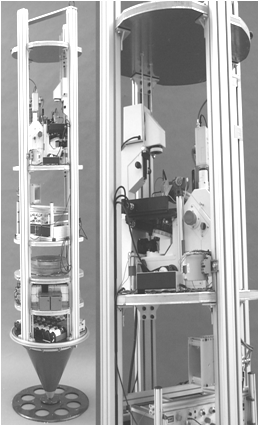micro-channel injector technology for bubble generation (BubGen)

research area: fluid dynamics
experiment title:
Micro-channel Injector Technology for Bubble Generation under Microgravity
experiment acronym: BubGen
funding agency: DLR
grant number: -
performing organization:
Departament d’Estrucura i Constituents de la Matèria, Facultat de Física – Universitat de Barcelona, Spain /
ZARM, Universität Bremen
prime investigator:
J. Carrera, X. Ruiz, L. Ramírez-Piscina, J. Casademunt /
PD Dr. Michael Dreyer
experiment objective
abstract
A new method to create a jet of a virtually monodisperse microbubble suspension of prescribed bubble size into a quiescent cavity is proposed. The method is insensitive to gravity and is based on the creation of a slug flow at a T junction in a capillary tube before injection. We develop a theoretical analysis that establishes the validity and efficiency of the method, as controlled by the crossflow Weber number, and yields a simple explicit prediction for the bubble size in terms of the injection parameters. The method operates efficiently for small Weber numbers, yet it generates small bubbles of very uniform size. The reduced size dispersion is also explained within the theoretical model. The method of bubble formation, injection, and spreading by the resulting turbulent jet is validated experimentally in 4.7 s of free fall in the drop tower at the University of Bremen. Experiments demonstrate the physical principle behind the method of bubble formation and allow us to explore the dynamics of the resulting bubble jet after injection of the slug flow into a quiescent cavity in microgravity conditions as an efficient method of bubble spreading and transport. Detailed measurements of average local velocities show that bubbles are essentially passive with respect to the carrier mean flow, and the inherent turbulence of the flow is crucial for optimal spreading of the bubble distribution and reduction of bubble coalescence. The shape of the bubble jet is studied as a function of the Reynolds number. Finally, the degree of coalescence is also characterized and found to be remarkably small.
related publications
- Carrera J., Ruiz X., Ramirez-Piscina L., Casademunt J., Dreyer M. E.: Generation of a Monodisperse Microbubble Jet in Microgravity, AIAA Journal 46 (8), 2010-2019 (2008)
experiment campaigns
experiment year: 2003
number of drops: 12


 "
"